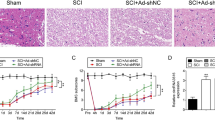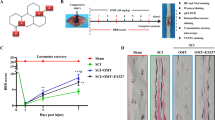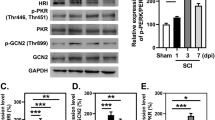Abstract
Spinal cord injury (SCI) is a severe clinical problem worldwide. The pathogenesis of SCI is complicated and much is unknown. The current study was designed to investigate the possible role of regulator of calcineurin 1 (RCAN1) in SCI and to explore the possible molecular mechanisms. Rats were injected with LVshRNAi-RCAN1 and then contusion-induced SCI was established. We found that RCAN1 was significantly increased in spinal cord of rats with SCI. Knockdown of RCAN1 markedly facilitated the structural and functional recovery in the spinal cord, as illustrated by decrease of lesion volume and increase of Basso, Beattie, and Bresnahan (BBB) and combined behavioral score (CBS) scores. Downregulation of RCAN1 suppressed the increase of pro-inflammatory cytokines, including IL-1β and TNF-α, and inhibited the increase of TUNEL-positive cell numbers and caspases 3 and 9 activities. The decrease of oxygen consumption rate and increase of expression of glucose-regulated protein 78 (GRP78) and phosphorylation of protein kinase RNA-like endoplasmic reticulum (ER) kinase (PERK) in rats with SCI were inhibited by LVshRNAi-RCAN1. Moreover, knockdown of RCAN1 ameliorated oxidative stress in rats with SCI, as evidenced by decrease of TBA reactive substances (TBARS) and GSSG content and increase of glutathione (GSH) level. These results suggested that RCAN1 played an important role in SCI through regulation of various pathological processes. Overall, the data provide novel insights into the role of RCAN1 in SCI and novel therapeutic targets of the treatment of injury in the spinal cord.






Similar content being viewed by others
References
Allison DJ, Ditor DS (2015) Targeting inflammation to influence mood following spinal cord injury: a randomized clinical trial. J Neuroinflammation 12:204
Basso DM, Beattie MS, Bresnahan JC (1995) A sensitive and reliable locomotor rating scale for open field testing in rats. J Neurotrauma 12:1–21
Belmont PJ, Tadimalla A, Chen WJ, Martindale JJ, Thuerauf DJ, Marcinko M, Gude N, Sussman MA, Glembotski CC (2008) Coordination of growth and endoplasmic reticulum stress signaling by regulator of calcineurin 1 (RCAN1), a novel ATF6-inducible gene. J Biol Chem 283:14012–14021
Block ML, Zecca L, Hong JS (2007) Microglia-mediated neurotoxicity: uncovering the molecular mechanisms. Nat Rev Neurosci 8:57–69
Byrnes KR, Stoica BA, Fricke S, Di Giovanni S, Faden AI (2007) Cell cycle activation contributes to post-mitotic cell death and secondary damage after spinal cord injury. Brain 130:2977–2992
Center NSCIS (2013) Spinal cord injury facts and figures at a glance. J Spinal Cord Med 36:394–395
Chang KT, Shi YJ, Min KT (2003) The Drosophila homolog of Down’s syndrome critical region 1 gene regulates learning: implications for mental retardation. Proc Natl Acad Sci U S A 100:15794–15799
Cho KO, Kim YS, Cho YJ, Kim SY (2008) Upregulation of DSCR1 (RCAN1 or Adapt78) in the peri-infarct cortex after experimental stroke. Exp Neurol 212:85–92
DePaul MA, Palmer M, Lang BT, Cutrone R, Tran AP, Madalena KM, Bogaerts A, Hamilton JA, Deans RJ, Mays RW, Busch SA, Silver J (2015) Intravenous multipotent adult progenitor cell treatment decreases inflammation leading to functional recovery following spinal cord injury. Sci Rep 5:16795
Di Giovanni S, Knoblach SM, Brandoli C, Aden SA, Hoffman EP, Faden AI (2003) Gene profiling in spinal cord injury shows role of cell cycle in neuronal death. Ann Neurol 53:454–468
Ermak G, Hench KJ, Chang KT, Sachdev S, Davies KJ (2009) Regulator of calcineurin (RCAN1-1L) is deficient in Huntington disease and protective against mutant huntingtin toxicity in vitro. J Biol Chem 284:11845–11853
Ermak G, Sojitra S, Yin F, Cadenas E, Cuervo AM, Davies KJ (2012) Chronic expression of RCAN1-1L protein induces mitochondrial autophagy and metabolic shift from oxidative phosphorylation to glycolysis in neuronal cells. J Biol Chem 287:14088–14098
Fleming JC, Norenberg MD, Ramsay DA, Dekaban GA, Marcillo AE, Saenz AD, Pasquale-Styles M, Dietrich WD, Weaver LC (2006) The cellular inflammatory response in human spinal cords after injury. Brain 129:3249–3269
Fuentes JJ, Pritchard MA, Planas AM, Bosch A, Ferrer I, Estivill X (1995) A new human gene from the Down syndrome critical region encodes a proline-rich protein highly expressed in fetal brain and heart. Hum Mol Genet 4:1935–1944
Gruner JA (1992) A monitored contusion model of spinal cord injury in the rat. J Neurotrauma 9:123–126, 126-128
Harris CD, Ermak G, Davies KJ (2007) RCAN1-1L is overexpressed in neurons of Alzheimer’s disease patients. FEBS J 274:1715–1724
Hart JE, Morse L, Tun CG, Brown R, Garshick E (2015) Cross-sectional associations of pulmonary function with systemic inflammation and oxidative stress in individuals with chronic spinal cord injury. J Spinal Cord Med 39(3):344–52
Huang SQ, Tang CL, Sun SQ, Yang C, Xu J, Wang KJ, Lu WT, Huang J, Zhuo F, Qiu GP, Wu XY, Qi W (2014) Demyelination initiated by oligodendrocyte apoptosis through enhancing endoplasmic reticulum-mitochondria interactions and Id2 expression after compressed spinal cord injury in rats. CNS Neurosci Ther 20:20–31
Jiang ZS, Pu ZC, Hao ZH (2015) Carvacrol protects against spinal cord injury in rats via suppressing oxidative stress and the endothelial nitric oxide synthase pathway. Mol Med Rep 12:5349–5354
Jin M, Yang YW, Cheng WP, Lu JK, Hou SY, Dong XH, Liu SY (2015) Serine-threonine protein kinase activation may be an effective target for reducing neuronal apoptosis after spinal cord injury. Neural Regen Res 10:1830–1835
Lee KD, Chow WN, Sato-Bigbee C, Graf MR, Graham RS, Colello RJ, Young HF, Mathern BE (2009) FTY720 reduces inflammation and promotes functional recovery after spinal cord injury. J Neurotrauma 26:2335–2344
Li G, Yan W, Dang Y, Li J, Liu C, Wang J (2015) The role of calcineurin signaling in microcystin-LR triggered neuronal toxicity. Sci Rep 5:11271
Lin HY, Michtalik HJ, Zhang S, Andersen TT, Van Riper DA, Davies KK, Ermak G, Petti LM, Nachod S, Narayan AV, Bhatt N, Crawford DR (2003) Oxidative and calcium stress regulate DSCR1 (Adapt78/MCIP1) protein. Free Radic Biol Med 35:528–539
Liu J, Du L (2015) PERK pathway is involved in oxygen-glucose-serum deprivation-induced NF-kB activation via ROS generation in spinal cord astrocytes. Biochem Biophys Res Commun 467:197–203
Long Z, Zhang X, Sun Q, Liu Y, Liao N, Wu H, Wang X, Hai C (2015) Evolution of metabolic disorder in rats fed high sucrose or high fat diet: focus on redox state and mitochondrial function. Gen Comp Endocrinol. doi:10.1016/j.ygcen.2015.10.012
Luo Y, Fu C, Wang Z, Zhang Z, Wang H, Liu Y (2015) Mangiferin attenuates contusive spinal cord injury in rats through the regulation of oxidative stress, inflammation and the Bcl2 and Bax pathway. Mol Med Rep 12:7132–7138
Martin KR, Corlett A, Dubach D, Mustafa T, Coleman HA, Parkington HC, Merson TD, Bourne JA, Porta S, Arbones ML, Finkelstein DI, Pritchard MA (2012) Over-expression of RCAN1 causes Down syndrome-like hippocampal deficits that alter learning and memory. Hum Mol Genet 21:3025–3041
Moghimian M, Kashani F, Cheraghi MA, Mohammadnejad E (2015) Quality of life and related factors among people with spinal cord injuries in Tehran, Iran. Arch Trauma Res 4:e19280
Pan F, Cheng YX, Zhu CL, Tao FH, Li ZH, Tao HY, He B, Yu L, Ji P, Tang H (2013) Tacolimus postconditioning alleviates apoptotic cell death in rats after spinal cord ischemia-reperfusion injury via up-regulating protein-serine-threonine kinases phosphorylation. J Huazhong Univ Sci Technolog Med Sci 33:852–856
Porta S, Serra SA, Huch M, Valverde MA, Llorens F, Estivill X, Arbones ML, Marti E (2007) RCAN1 (DSCR1) increases neuronal susceptibility to oxidative stress: a potential pathogenic process in neurodegeneration. Hum Mol Genet 16:1039–1050
Shou-Shi W, Ting-Ting S, Ji-Shun N, Hai-Chen C (2015) Preclinical efficacy of Dexmedetomidine on spinal cord injury provoked oxidative renal damage. Ren Fail 37:1190–1197
Sun X, Wu Y, Chen B, Zhang Z, Zhou W, Tong Y, Yuan J, Xia K, Gronemeyer H, Flavell RA, Song W (2011) Regulator of calcineurin 1 (RCAN1) facilitates neuronal apoptosis through caspase-3 activation. J Biol Chem 286:9049–9062
Sun X, Wu Y, Herculano B, Song W (2014) RCAN1 overexpression exacerbates calcium overloading-induced neuronal apoptosis. PLoS ONE 9:e95471
Wong H, Levenga J, Cain P, Rothermel B, Klann E, Hoeffer C (2015) RCAN1 overexpression promotes age-dependent mitochondrial dysregulation related to neurodegeneration in Alzheimer’s disease. Acta Neuropathologica 130(6):829–43
Wu Y, Song W (2013) Regulation of RCAN1 translation and its role in oxidative stress-induced apoptosis. FASEB J 27:208–221
Wu J, Stoica BA, Dinizo M, Pajoohesh-Ganji A, Piao C, Faden AI (2012) Delayed cell cycle pathway modulation facilitates recovery after spinal cord injury. Cell Cycle 11:1782–1795
Wyndaele M, Wyndaele JJ (2006) Incidence, prevalence and epidemiology of spinal cord injury: what learns a worldwide literature survey? Spinal Cord 44:523–529
Yu D, Thakor DK, Han I, Ropper AE, Haragopal H, Sidman RL, Zafonte R, Schachter SC, Teng YD (2013) Alleviation of chronic pain following rat spinal cord compression injury with multimodal actions of huperzine a. Proc Natl Acad Sci U S A 110:E746–E755
Zhang YK, Liu JT, Peng ZW, Fan H, Yao AH, Cheng P, Liu L, Ju G, Kuang F (2013) Different TLR4 expression and microglia/macrophage activation induced by hemorrhage in the rat spinal cord after compressive injury. J Neuroinflammation 10:112
Zhou Y, Zhang H, Zheng B, Ye L, Zhu S, Johnson NR, Wang Z, Wei X, Chen D, Cao G, Fu X, Li X, Xu HZ, Xiao J (2016) Retinoic acid induced-autophagic flux inhibits ER-stress dependent apoptosis and prevents disruption of blood-spinal cord barrier after spinal cord injury. Int J Biol Sci 12:87–99
Author information
Authors and Affiliations
Corresponding author
Ethics declarations
All animal experiments were conducted in accordance with the National Institute of Health Guide on the Care and Use of Laboratory Animals and were approved by the Laboratory Animal Users Committee at Xinxiang Medical University (XX201502-3).
Conflict of interest
The authors declare that they have no conflicts of interest.
Rights and permissions
About this article
Cite this article
Wang, G., Zhao, Y., Liu, S. et al. Critical role of regulator of calcineurin 1 in spinal cord injury. J Physiol Biochem 72, 605–613 (2016). https://doi.org/10.1007/s13105-016-0499-z
Received:
Accepted:
Published:
Issue Date:
DOI: https://doi.org/10.1007/s13105-016-0499-z




